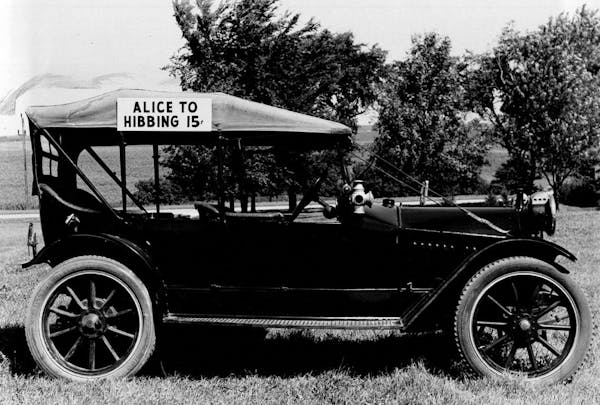The first thing the 18-year-old Swedish immigrant did, upon his 1905 arrival on Minnesota's Iron Range, was change his name. Martis Jerk became Carl Eric Wickman. It would prove to be one of several smart decisions for the innovative Swede, who had a knack for wisely remaking things. Wickman worked as a driller in Hibbing's iron ore mines until he was laid off in 1914. He decided to move from his mine to an automobile showroom. A couple of brothers in Grand Rapids, Mich., Robert and Louis Hupp, were early rivals of Ford and Chevrolet. Wickman landed a Hupmobile dealership in Hibbing.
One problem: He failed to sell his first Hupmobile, a seven-seater. Underpaid miners could ill afford a new car. So in 1914, Wickman and his partner, Andy Anderson, got behind the wheel of that large car and began shuttling miners a couple of miles between Hibbing and Alice — a mining community later gobbled up by Hibbing.
Wickman charged 15 cents a ride. A century and several mergers and expansions later, Greyhound is North America's largest bus company with nearly 1,300 buses, 4,000 destinations and 5.5 billion ride miles a year.
It's easy to deride Greyhound and, what the Washington Post recently called "its long-standing image as the chariot of absolute last resort." The late singer Harry Chapin, in a song titled "Greyhound," sings in the chorus: "Take the Greyhound, it's a dog of a way to get around. Take the Greyhound, it's a dog gone easy way to get you down."
When I was 17, I used my summer wages earned cleaning up poop at a dog kennel to buy a month pass on Greyhound. Old journals are littered with memories of crying infants, gospel music playing on transistor radios, reeking fellow passengers and midnight rest stops in North Platte, Neb., on my way to Seattle. Years later, everyone on a ride from Maryland to Virginia was busy watching movies on their phones — ear buds in; talking out.
But how did this grass-roots bus operation that started shuttling miners in Hibbing survive for 100 years when other early transportation start-ups from California to Georgia to Maine all fizzled?
English historian Margaret Walsh, in a 1985 article in Minnesota History magazine, attributes some of the longevity to a rare sense of cooperation between the fledgling bus company and the powerful Great Northern Railroad in the 1920s.
As some railroads slashed prices in hopes of rubbing out bus competition, Great Northern President Ralph Budd scuttled plans to start his own bus company and used his vast railroad capital to go into business with Wickman in 1925. Their $2.5 million merger of eight independent lines left Great Northern with an 80 percent stake and Wickman's Northland Transportation Co. with $240,000 of rail dough to finance 150 buses dominating the region.
Within five years, the company would add Greyhound to its name, a running dog to its logo and move the headquarters to Chicago, where the Great Depression would sink it into deep debt.
But the railroad's decision to pour money into its bus rivals, rather than try to pummel them, proved critical in Greyhound's puppy years. The Great Northern, known for its ruthlessness under founder James J. Hill, adopted a more 'Minnesota Nice" style under Budd.
"Their view was that cooperation was a more fruitful path," Walsh wrote in her article.
In Hibbing there is a May-through-September Greyhound Bus Museum, complete with old coaches and 1930s drivers' uniforms with tall boots and double-breasted jackets. The museum attracts 3,000 visitors a year.
But they can't ride Greyhound to get there. The company cut off service to Hibbing in 1973 — joining Bob Dylan, Roger Maris, Kevin McHale and Rudy Perpich, who all started off in Hibbing.
"Only to leave and not come back," said Ron Dicklich, a former legislator and now the museum's director. "But it's a business, and we get that."
When the town renamed 3rd Avenue East "Greyhound Boulevard" in 1984, then-company President Frederick Dunikoski did come back to say Hibbing "is our birthplace. It's like Plymouth Rock."
And it's all thanks to a laid-off miner and lousy car-selling Swede once named Jerk.
Curt Brown's weekly tale on Minnesota's history will appear each Sunday. Readers can send him ideas and suggestions at mnhistory@startribune.com.
Judge declines to dismiss lawsuits filed against rapper Travis Scott over deadly Astroworld concert

Summer Movie Guide: Virtually all the movies coming to theaters and streaming from May to Labor Day

